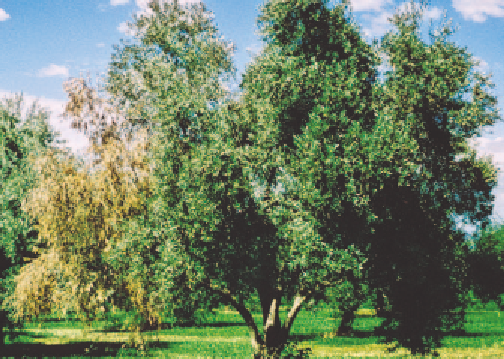Agriculture Reference
In-Depth Information
VERTICILLIUM WILT
Avoid soil and water movement from affected to non-
affected areas.
•
■
Cause
The fungus
Verticillium dahliae
.
Reduce inoculum levels before replanting by keeping the
area weed-free and growing resistant plants (e.g. grasses)
for several years.
•
Symptoms
One or more branches wilt, usually early in the growing
season. Dead leaves remain attached to the tree. Internal
tissues in the lower stem may darken as the infection
progresses. Olive varieties vary considerably in
susceptibility and symptoms may take from four to eight
years to express following initial infection.
Avoid over irrigating or excessive fertilisation, because
rapid growth encourages infection.
•
Clean machinery leaving and entering groves.
•
WOUND CANKERS
■
Cause
Several fungi and bacteria including
Botryosphaeria
sp.
,
Pycnoporus coccineus, Pseudomonas syringae, Ralstonia
solanacearum
and
Xanthomonas campestris
.
Source of infection and spread
The fungus is soil-borne, has a wide host range among
crop and weed species and can survive in soils for several
decades. It is spread by irrigation and drainage water and
by the movement of infested soil on machinery and
vehicles.
Symptoms
The symptoms vary from a slow decline of trees, tree death
or localised cankers around wound sites with occasional
branch death above the infection.
Disease development is favoured by cool, moist conditions.
Importance
Verticillium wilt can be a problem in olive groves planted
in land that previously grew susceptible crops.
Source of infection and spread
Infection is through wounds occurring during pruning
and cultivation or from hail, frost, wind or damage caused
by feeding insects. Infection is favoured by wet, humid
conditions around the wound site.
Management
•
Avoid planting olives in land that previously grew
susceptible crops. These include cotton, stone fruit,
potato, tomato, eggplant, lucerne and brassicas.
Management
•
Avoid wounding trees.
Plant healthy stock.
•
Copper and wound dressings can be used as protectants,
but these products will not eradicate established
infections.
•
Avoid inter-row cropping with susceptible plants
(e.g. clover).
•
Fig 13.13 Canker symptoms showing early stage of slow decline.
UNDETERMINED CAUSE
APICAL END ROT (SOFT NOSE)
■
Cause
The cause of apical end rot is unknown. It may result from
sudden changes in temperature and humidity, which
Fig 13.12 Verticillium wilt. One or more branches may die.













